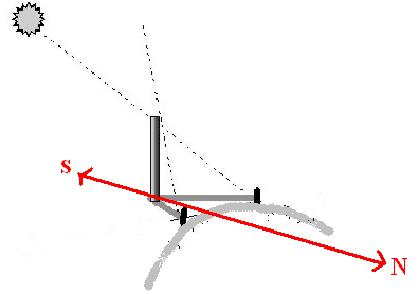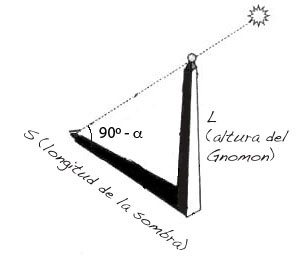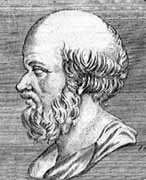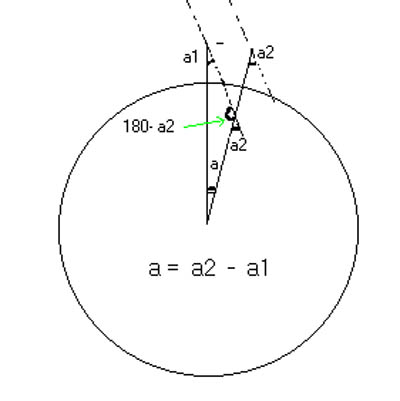Midiendo el Sistema Solar desde el aula
https://www.fisicarecreativa.com/exp_fisica/cap12_Astronomia_v0.pdf
Sobre los Tamaños y Distancias del Sol y la Luna
https://webs.um.es/bussons/sol_tamanyoydistancia.pdf
https://digital.csic.es/bitstream/10261/83225/3/dimension.pdf
Física re-Creativa
https://www.fisicarecreativa.com/
Eratóstenes:La medida del radio terrestre
http://joseluislorente.es/ERATOSTENES/medida_del_ngulo.html
Medida del ángulo
Según el historiador Cleomedes, para el cálculo del ángulo, Eratóstenes midió la sombra que el Sol proyectaba al mediodía del solsticio de verano, sobre un scaphium o gnomon. Otros historiadores defienden que midió la sombra de una torre.
Pero, ¿qué es un gnomon?.
Pues el colmo de la sencillez: un palo perpendicular al suelo. Nosotros utilizaremos un recogedor.
Para medir el ángulo  pudo seguir cualquiera de estos dos métodos.
pudo seguir cualquiera de estos dos métodos.
- Dibujar el triángulo a escala y utilizar un transportador de ángulos (semejanza de triángulos)
- Para aquellos alumnos aventajados (4º ESO en adelante), utilizar la siguiente expresión:

Sea como fuere, Eratóstenes obtuvo una medida para la diferencia de latitud geográfica entre Siena y Alejandría de 1/50 parte de la circunferencia, es decir, unos 7º 12'.
https://mathshistory.st-andrews.ac.uk/Biographies/Eratosthenes/
Eratosthenes of Cyrene
Quick Info
Cyrene, North Africa (now Shahhat, Libya)
Alexandria, Egypt
Biography
Eratosthenes was born in Cyrene which is now in Libya in North Africa. His teachers included the scholar Lysanias of Cyrene and the philosopher Ariston of Chios who had studied under Zeno, the founder of the Stoic school of philosophy. Eratosthenes also studied under the poet and scholar Callimachus who had also been born in Cyrene. Eratosthenes then spent some years studying in Athens.The library at Alexandria was planned by Ptolemy I Soter and the project came to fruition under his son Ptolemy II Philadelphus. The library was based on copies of the works in the library of Aristotle. Ptolemy II Philadelphus appointed one of Eratosthenes' teachers Callimachus as the second librarian. When Ptolemy III Euergetes succeeded his father in 245 BC and he persuaded Eratosthenes to go to Alexandria as the tutor of his son Philopator. On the death of Callimachus in about 240 BC, Eratosthenes became the third librarian at Alexandria, in the library in a temple of the Muses called the Mouseion. The library is said to have contained hundreds of thousands of papyrus and vellum scrolls.
Despite being a leading all-round scholar, Eratosthenes was considered to fall short of the highest rank. Heath writes [4]:-
[Eratosthenes] was, indeed, recognised by his contemporaries as a man of great distinction in all branches of knowledge, though in each subject he just fell short of the highest place. On the latter ground he was called Beta, and another nickname applied to him, Pentathlos, has the same implication, representing as it does an all-round athlete who was not the first runner or wrestler but took the second prize in these contests as well as others.Certainly this is a harsh nickname to give to a man whose accomplishments in many different areas are remembered today not only as historically important but, remarkably in many cases, still providing a basis for modern scientific methods.
One of the important works of Eratosthenes was Platonicus which dealt with the mathematics which underlie Plato's philosophy. This work was heavily used by Theon of Smyrna when he wrote Expositio rerum mathematicarum and, although Platonicus is now lost, Theon of Smyrna tells us that Eratosthenes' work studied the basic definitions of geometry and arithmetic, as well as covering such topics as music.
One rather surprising source of information concerning Eratosthenes is from a forged letter. In his commentary on Proposition 1 of Archimedes' Sphere and cylinder Book II, Eutocius reproduces a letter reputed to have been written by Eratosthenes to Ptolemy III Euergetes. The letter describes the history of the problem of the duplication of the cube and, in particular, it describes a mechanical device invented by Eratosthenes to find line segments and so that, for given segments and ,
Other details of what Eratosthenes wrote in Platonicus are given by Theon of Smyrna. In particular he described there the history of the problem of duplicating the cube (see Heath [4]):-
... when the god proclaimed to the Delians through the oracle that, in order to get rid of a plague, they should construct an alter double that of the existing one, their craftsmen fell into great perplexity in their efforts to discover how a solid could be made the double of a similar solid; they therefore went to ask Plato about it, and he replied that the oracle meant, not that the god wanted an alter of double the size, but that he wished, in setting them the task, to shame the Greeks for their neglect of mathematics and their contempt of geometry.Eratosthenes erected a column at Alexandria with an epigram inscribed on it relating to his own mechanical solution to the problem of doubling the cube [4]:-
If, good friend, thou mindest to obtain from any small cube a cube the double of it, and duly to change any solid figure into another, this is in thy power; thou canst find the measure of a fold, a pit, or the broad basin of a hollow well, by this method, that is, if thou thus catch between two rulers two means with their extreme ends converging. Do not thou seek to do the difficult business of Archytas's cylinders, or to cut the cone in the triads of Menaechmus, or to compass such a curved form of lines as is described by the god-fearing Eudoxus. Nay thou couldst, on these tablets, easily find a myriad of means, beginning from a small base. Happy art thou, Ptolemy, in that, as a father the equal of his son in youthful vigour, thou hast thyself given him all that is dear to muses and Kings, and may be in the future, O Zeus, god of heaven, also receive the sceptre at thy hands. Thus may it be, and let any one who sees this offering say "This is the gift of Eratosthenes of Cyrene".Eratosthenes also worked on prime numbers. He is remembered for his prime number sieve, the 'Sieve of Eratosthenes' which, in modified form, is still an important tool in number theory research. The sieve appears in the Introduction to arithmetic by Nicomedes.
Another book written by Eratosthenes was On means and, although it is now lost, it is mentioned by Pappus as one of the great books of geometry. In the field of geodesy, however, Eratosthenes will always be remembered for his measurements of the Earth.
Eratosthenes made a surprisingly accurate measurement of the circumference of the Earth. Details were given in his treatise On the measurement of the Earth which is now lost. However, some details of these calculations appear in works by other authors such as Cleomedes, Theon of Smyrna and Strabo. Eratosthenes compared the noon shadow at midsummer between Syene (now Aswan on the Nile in Egypt) and Alexandria. He assumed that the sun was so far away that its rays were essentially parallel, and then with a knowledge of the distance between Syene and Alexandria, he gave the length of the circumference of the Earth as 250,000 stadia.
Of course how accurate this value is depends on the length of the stadium and scholars have argued over this for a long time. The article [11] discusses the various values scholars have given for the stadium. It is certainly true that Eratosthenes obtained a good result, even a remarkable result if one takes 157.2 metres for the stadium as some have deduced from values given by Pliny. It is less good if 166.7 metres was the value used by Eratosthenes as Gulbekian suggests in [11].
Several of the papers referenced, for example [10], [15] and [16], discuss the accuracy of Eratosthenes' result. The paper [15] is particularly interesting. In it Rawlins argues convincingly that the only measurement which Eratosthenes made himself in his calculations was the zenith distance on the summer solstice at Alexandria, and that he obtained the value of 7°12'. Rawlins argues that this is in error by 16' while other data which Eratosthenes used, from unknown sources, was considerably more accurate.
Eratosthenes also measured the distance to the sun as 804,000,000 stadia and the distance to the Moon as 780,000 stadia. He computed these distances using data obtained during lunar eclipses. Ptolemy tells us that Eratosthenes measured the tilt of the Earth's axis with great accuracy obtaining the value of of 180°, namely 23° 51' 15".
The value has fascinated historians of mathematics, for example the papers [9] and [17] are written just to examine the source of this value. Perhaps the most commonly held view is that the value is due to Ptolemy and not to Eratosthenes. Heath [4] argues that Eratosthenes used 24° and that of 180° was a refinement due to Ptolemy. Taisbak [17] agrees with attributing to Ptolemy although he believes that Eratosthenes used the value of 180°. However Rawlins [15] believes that a continued fraction method was used to calculate the value while Fowler [9] proposes that the anthyphairesis (or Euclidean algorithm) method was used (see also [3]).
Eratosthenes made many other major contributions to the progress of science. He worked out a calendar that included leap years, and he laid the foundations of a systematic chronography of the world when he tried to give the dates of literary and political events from the time of the siege of Troy. He is also said to have compiled a star catalogue containing 675 stars.
Eratosthenes made major contributions to geography. He sketched, quite accurately, the route of the Nile to Khartoum, showing the two Ethiopian tributaries. He also suggested that lakes were the source of the river. A study of the Nile had been made by many scholars before Eratosthenes and they had attempted to explain the rather strange behaviour of the river, but most like Thales were quite wrong in their explanations. Eratosthenes was the first to give what is essentially the correct answer when he suggested that heavy rains sometimes fell in regions near the source of the river and that these would explain the flooding lower down the river. Another contribution that Eratosthenes made to geography was his description of the region "Eudaimon Arabia", now the Yemen, as inhabited by four different races. The situation was somewhat more complicated than that proposed by Eratosthenes, but today the names for the races proposed by Eratosthenes, namely Minaeans, Sabaeans, Qatabanians, and Hadramites, are still used.
Eratosthenes writings include the poem Hermes, inspired by astronomy, as well as literary works on the theatre and on ethics which was a favourite topic of the Greeks. Eratosthenes is said to have became blind in old age and it has been claimed that he committed suicide by starvation.
On the Sizes and Distances (Aristarchus)
On the Sizes and Distances (of the Sun and Moon) (Περὶ μεγεθῶν καὶ ἀποστημάτων [ἡλίου καὶ σελήνης], Peri megethon kai apostematon) is widely accepted as the only extant work written by Aristarchus of Samos, an ancient Greek astronomer who lived circa 310–230 BCE. This work calculates the sizes of the Sun and Moon, as well as their distances from the Earth in terms of Earth's radius.
The book was presumably preserved by students of Pappus of Alexandria's course in mathematics, although there is no evidence of this. The editio princeps was published by John Wallis in 1688, using several medieval manuscripts compiled by Sir Henry Savile.[1] The earliest Latin translation was made by Giorgio Valla in 1488. There is also a 1572 Latin translation and commentary by Frederico Commandino.[2][3]
Results[edit]
The above formulae can be used to reconstruct the results of Aristarchus. The following table shows the results of a long-standing (but dubious) reconstruction using n = 2, x = 19.1 (φ = 87°) and θ = 1°, alongside the modern day accepted values.
| Quantity | Relation | Reconstruction | Modern |
|---|---|---|---|
| s/t | Sun's radius in Earth radii | 6.7 | 109 |
| t/ℓ | Earth's radius in Moon radii | 2.85 | 3.50 |
| L/t | Earth-Moon distance in Earth radii | 20 | 60.32 |
| S/t | Earth-Sun distance in Earth radii | 380 | 23,500 |
http://joseluislorente.es/astronomia/radio.htm
2. Experimento realizado en el Instituto
¿CÓMO MIDIÓ ERATÓSTENES?
Eratóstenes, nacido en Cirene en el año 284 antes de Jesucristo, y muerto en Alejandría a los 92 años, fue el primer científico de la historia de la Humanidad en medir con bastante precisión, la circunferencia de nuestro planeta.
Eratóstenes midió la circunferencia terrestre por primera vez con una gran exactitud, en una época en la que muy poca gente pensaba que el mundo no era plano como una mesa.
Pero, ¿cómo lo hizo?. ¿En qué se basó para hacer la medida del radio de la esfera terrestre?
Figura 1Pues, pensó, sencillamente, que dos estacas clavadas verticalmente en el suelo, a una distancia de varios kilómetros, sobre un mismo meridiano, darían sombras distintas a una misma hora en virtud de la curvatura de la superficie del planeta.
Los ángulos que forman los rayos de sol con la dirección de la estaca son:
a1=arctg(s/d) y a2=arctg(s'/d)
Siendo s y s’ la sombra de cada estaca sobre la línea meridiana en cada lugar. La longitud de la estaca es d en ambos casos.
Si observamos ahora la figura 2 y nos fijamos en el triángulo que se forma, con ángulos a ,a1 y 180-a2 donde a es el ángulo del arco de meridiano comprendido entre las posiciones que ocupan ambas estacas, y a1 y a2 son los ángulos que forman los rayos solares con la dirección de las estacas, vemos que, al sumar 180º los tres ángulos del triángulo es:
a1 + 180 - a2 + a = 180, es decir: a1– a2 + a = 0, o sea: a = a2 –a1
Figura 2Conocido el ángulo a, y la longitud L del arco de meridiano entre ambos puntos de colocación de las estacas, será posible, mediante una sencilla regla de tres, encontrar la longitud total, X, de la circunferencia del planeta:
y, de aquí, el radio medio de la Tierra:
Si una de las dos estacas, en un determinado momento diera sobre la línea meridiana sombra nula, es decir, si en una de las estacas fuera cero el ángulo que forma la dirección de los rayos solares con la estaca, o, dicho de otra manera, si en uno de los dos lugares los rayos solares inciden perpendicularmente, entonces, se tendría que:
a1 = 0, por lo cual a = a2 – 0 = a2, es decir, el ángulo, a, que corresponde al arco de meridiano terrestre comprendido entre ambas posiciones de las estacas, es, precisamente el ángulo, a2, que formarían los rayos solares con la segunda estaca sobre la línea meridiana.
Este último hecho fue lo que utilizó Eratóstenes para hacer su medición.
Eratóstenes, que estaba en Alejandría, recordó que en un cierto día del año, en el solsticio de verano, los rayos solares caían verticalmente en la ciudad de Siena, situada en el mismo meridiano que Alejandría, pues recordaba que el sol se reflejaba en lo mas profundo de los pozos, a la hora del mediodía. Entonces, pensó que si media ese día en la ciudad de Alejandría, a la misma hora, el ángulo, a2, que los rayos solares formaban con la vertical, midiendo la sombra que sobre la línea meridiana formaba la estaca, conocería el ángulo del arco de meridiano entre Alejandría y Siena.
Eratóstenes midió la sombra sobre la línea meridiana producida por una estaca vertical en Alejandría, y conociendo la longitud de la estaca halló ese ángulo a la hora antedicha: resultó que el ángulo era de 7 grados (a2 = 7º). Ya sabia el ángulo del arco de meridiano entre Alejandría y Siena. Ahora faltaba conocer la distancia, a lo largo del meridiano, entre ambas ciudades, es decir, la longitud del arco L. Para ello Eratóstenes pagó a un hombre que hizo, a pié, tal medición. Eran, usando la medida usual en la época y en la zona, unos 4900 estadios, que equivaldría hoy ( a unos 6’125 estadios por kilómetro) a unos 800 kms.
Con estos datos ya es inmediato el cálculo:
Longitud de la circunferencia terrestre:
Radio medio del planeta:
Experimento realizado en el Instituto
Todo empezó con a partir de la llamada desde la WEB de Astronomía 2009 a los institutos españoles en repetir el experimento de Erastótenes, con una salvedad esta vez no había que caminar y contar los pasos entre los distintos institutos...para calcular las distancias puedes usar el visor sigpac.
El caso es que desde más de 800 instituto, nos disponemos al cálculo de la altura solar (ángulo que forma el sol con el suelo horizontal) en el mismo instante solar (el Sol ocupe en todos ellos la misma posición). Pero surge el problema de que en cada instituto situado en distinto mismo meridiano... Esto implica que la hora solar es distinta en cada instituto. Tenemos que ponernos de acuerdo en la misma hora solar; la más sencilla de conocer es el MEDIODIA SOLAR, punto en el que el Sol situado en el punto más alto, y por tanto cuando la sombra del gnomon es la menor.
El experimento se realizó el día 26 de marzo, antes del cambio de hora de Verano (29 de Marzo), por lo que el medio día solar en el meridiano de Greenwich (Castellón) era en torno a las 13:00. Como Saldaña situada en la longitud 4,44 W el Sol "tardará en llegar" a nuestro instituto unos 18 minutos (15°=1 hora). Así que en torno a las 13:20 sería el medio día solar en Saldaña, instante en el que tendremos que medir la sombra de nuestro gnomon (un recogedor) para así calcular la altura del Sol.
Los alumnos de 4º ESO, ayudados de los de 3º ESO, 1º Bachillerato y 1º ESO realizaron medidas de la sombra del cogedor, nuestro gnomon, desde las 12:56 hasta las 13:51, rango horario donde se encuentra el Mediodía solar de Saldaña para ese día. La sombra que se produce es una parábola:

El vértice de la parábola es el punto con menor sombra del gnomon, es decir cuando el Sol situado en el punto más alto, ¡¡hemos encontrado el Mediodía Solar!!. Además con esta experiencia conocemos:
1. La recta que nos indica el Norte y el Sur (recta que pasa por el pie del gnomon y el vértice de la parábola)
2. El mediodía solar de Saldaña para el día 26 de Marzo.
3. Midiendo la sombra del gnomon a esta hora y el propio gnomon calculamos la altura solar, que necesitamos para calcular el radio de la Tierra.
Los datos obtenidos son los siguientes:
| Hora | Sombra(cm) | Altura solar |
| 12:56 | 86 | 49,6 |
| 13:01 | 85 | 49,9 |
| 13:06 | 84,7 | 50,0 |
| 13:11 | 84,5 | 50,1 |
| 13:16 | 84,3 | 50,1 |
| 13:21 | 84 | 50,3 |
| 13:26 | 84,1 | 50,2 |
| 13:31 | 84,5 | 50,1 |
| 13:36 | 84,7 | 50,0 |
| 13:41 | 85,3 | 49,8 |
| 13:46 | 86,2 | 49,5 |
| 13:51 | 86,5 | 49,4 |
| Tamaño gnomon | 101 |
Vemos que el mediodía solar está entre las 13:16 y las 13:26, cuando la sombra es la menor. La altura solar en Saldaña el día 26de Marzo al mediodía será próxima a 50°. Para calcular el vértice utilizamos la herramienta de Excel de representación lineal y del cálculo de la línea de tendencia, obteniendo la siguiente gráfica

El vértice de la parábola se calcula, como bien sabemos, de la siguiente forma:
V(xo,yo) siendo xo=-b/2a=0,556=13:23; yo=f(xo)=84cm
Con estos resultados experimentales
Resultado experimentales Saldaña
| Altura Solar Mediodía | Hora solar |
| 50°12' | 13:23 |
En Internet hay una página que nos calcula los datos exactos, tanto de la altura como de la hora solar, sólo hay que introducir el día y la latitud y longitud de Saldaña (Latitud: 42°32' N y Longitud 4°44' W). La página es la siguiente: http://www.geocities.com/xgarciaf/java/orto.htm. Según esta página la altura solar y hora al mediodía ese día es:
Resultado Reales Saldaña
| Altura Solar Mediodía | Hora solar |
49°50' | 13:25 |
Para calcular el radio terrestre necesitamos los datos de otro instituto, de entre los muchos calculados hemos tomado los datos de los institutos de Málaga (Latitud 36° 40' y Longitud 4° 29' W) por dos razones: 1) La longitud es semejante a la de Saldaña 2) Es la ciudad de España más alejada a Saldaña
En Málaga los resultados son los siguientes:
Resultado Reales Málaga
| Altura Solar Mediodía | Hora solar |
55°50' | 13:24 |
distancia Málaga-Saldaña=677km
De esta forma la diferencia de latitud experimental entre Saldaña y Málaga es a= 55°50'- 50°12'=5°38'=5,63° y el Radio de la Tierra calculado es por tanto:
Resultados experimentales
![]()
![]()
Resultado real
R=6.378km
Error cometido: 8%
En la página de astronomía 2009 podemos ver los resultado de todos los institutos: resultados
Más enlaces:
http://www.astrored.org/usuarios/xgarciaf/orto1.htm
¿Cómo se han estimado las distancias?
En la sección anterior hemos utilizado una serie de números como el radio terrestre, la distancia a la Luna y el periodo de traslación de ésta alrededor de la Tierra. ¿Cómo se han obtenido estos números?.
La primera estimación precisa del tamaño de la Tierra la hizo el gran geógrafo de la antigüedad Eratóstenes (276?-195? a..C.). Eratóstenes había oído relatos de viajeros que decían que a mediodía del 21 de junio el sol no arrojaba sombra en un manantial de Syene (la moderna Assuán), y que por consiguiente su luz caía perpendicularmente sobre las cabezas de los observadores. Él, por su parte, sabía que en Alejandría (donde residía) el sol siempre arrojaba sombra. Por los datos que tenía consideró que Syene estaba justo al sur de Alejandría. Se le ocurrió entonces que si podía medir la longitud de la sombra del sol en Alejandría a la hora en que no había sombra en Syene, podría calcular la circunferencia de la Tierra. El 21 de junio Eratóstenes midió la sombra de un obelisco de Alejandría y mediante simple geometría calculo que la sombra proyectada correspondía a una desviación de los rayos solares respecto a la vertical de 7º 14'. Esto corresponde a 1/50 de la circunferencia total de la Tierra (360º). La circunferencia de la Tierra era por tanto igual a 50 veces la distancia que mediaba entre Syene y Alejandría. Pero, ¿Cuál era esa distancia?. Él sabía, por los viajeros, que los camellos necesitaban unos 50 días para cubrirla, y que un camello recorría cien estadios en un día. La distancia entre Syene y Alejandría era por la tanto de cinco mil estadios (50×100). Eratóstenes calculó por tanto que la circunferencia de la Tierra era de doscientos cincuenta mil estadios (50×5000). No estamos seguros de cuál es el equivalente exacto entre los estadios y los metros, pero los mejores cálculos otorgan unos 185 metros de largo. El "estadio griego", del cual proviene nuestra palabra estadio, era una carrera pedestre que tenía precisamente esa longitud. Según estos cálculos, Eratóstenes llegó a la conclusión de que la circunferencia terrestre medía unos 46.190 kilómetro, cifra que sobrepasa a la medida actual en un 15%, pero la esta estimación fue la más precisa que se ha hecho hasta los tiempos modernos.
¿Cómo se puede calcular la distancia que nos separa de la Luna?. Bien, el truco es similar al que empleó Eratóstenes. Tenemos que averiguar por ejemplo en qué lugar de la Tierra la Luna está saliendo por el horizonte y en qué lugar se haya justo sobre nuestras cabezas. La situación queda representada en la figura 11.

http://astronomia.net/cosmologia/lec109.htm





No hay comentarios:
Publicar un comentario